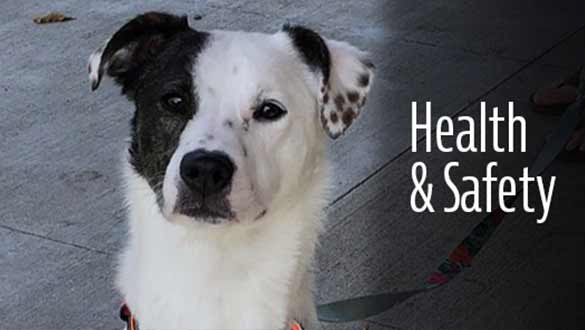What is “Doggie Dementia”?

We all want our dogs to live as long as possible, but with age comes a reasonable chance they will develop “doggie dementia”, or Canine Cognitive Dysfunction (CCD). A study at the University of California estimates that as much as 28 percent of dogs show signs of dementia by age 11 or 12. The risk of CCD increases with age, and small dogs are more susceptible. The study also found that by age 15 or 16, up to 68 percent of dogs have CCD. Since the condition is sometimes ignored or misdiagnosed, further education is necessary to help people prevent and recognize the disease and treat its symptoms.
The Hill’s pet food website has an easy mnemonic to use when watching for behavior changes related to CCD– DISH. Here’s what to look for:
- Disorientation. This behavior may look like pacing, getting stuck in corners or behind furniture, staring at objects, not recognizing people and other pets, and not responding to cues or their names.
- Interactions with family members. Changes in interaction may include not greeting family members, greeting less enthusiastically, seeking out less attention, or not wanting attention.
- Sleep and activity. This sign may include sleeping more during the day or less at night, becoming restless at sunset (sometimes called “sundowning”), and barking and howling at night.
- Housetraining. Your older dog may have accidents, become incontinent, or not make it to the door in time.
DISH is not comprehensive, and many other behaviors, such as being disinterested in surroundings, performing repetitive movements, lack of self-grooming, and irritability can also be indicative of CCD.
According to Pet MD, abnormal proteins in the brain can cause a build-up of plaque. This “eventually damages nerves and results in the loss of brain function, which can affect your dog’s memory, motor functions, and learned behavior.” Diagnosis may take time because some symptoms, such as toileting in the house, could be signs of other illnesses. Physical exams, CT scans, MRIs, and x-rays could all be part of the diagnostic process. Medication, such as dopamine-increasing Anipryl, can help relieve symptoms of CCD, but the disease itself is usually incurable.
Fortunately, there are ways to make life easier and more comfortable for a dog with dementia. These are just a few examples of ways to improve your dog’s life, and with a little creativity, you will likely discover dozens of others!
- Supervise dogs with dementia closely. From toileting on furniture to crashing into walls, dogs with this condition can easily hurt themselves, others, or your property. Dogs with CCD should not be outside by
themselves, as their wandering makes them “flight risks.” - Take your dog outdoors more often for potty breaks. Use belly bands, potty pads, and waterproof furniture covers to address potty issues.
- If mobility or spatial awareness becomes challenging, you could put down mats, build a ramp, and keep your pet and his/her belongings on one level or in one area. Try not to move furniture around, this can be a significant source of confusion for your pet.
- Provide orthopedic dog beds for comfort, night lights to help them navigate when it’s dark, as well as gentle exercise and a balanced diet.
Though vets usually cannot cure CCD, you may be able to prevent it, or at least lessen your dog’s risk. Playing games, taking your dog outside, and doing other activities to keep their mind sharp will reduce the risk of dementia while keeping them entertained! Antioxidants such as Omega 3 (the content of which can be found on dog food nutrition labels) have been found to reduce dementia, and your dog can likely get these from either regular kibble or a special supplement.
The veterinary community has conducted much research regarding CCD. In 2010, scientists at NCSU’s school of veterinary medicine discovered the gene that can sometimes lead to dementia in American Staffordshire Terriers. In 2015, scientists at the University of Sydney’s Mind and Brain Center used stem cell therapy to help Timmy, a 13-year-old dog with dementia. Shortly after, his toileting habits, levels of affection, sleeping habits, and navigation all improved. You can read about the treatment in more detail here. Researchers made it clear that more trials were needed, but nevertheless, it could pave the way for future treatments.
Canine dementia brings about major changes, just as human dementia does, but with compassion and creativity, you can improve and maintain your beloved pet’s quality of life.
Sources:
petmd.com/dog/conditions/neurological/c_dg_cognitive_dysfunction_syndrome
abc.net.au/news/science/2019-09-08/dog-dementia-more-common-as-pets-live-longer/11481852
thesprucepets.com/dementia-in-dogs-1117412
cvm.ncsu.edu/cvm-research-helps-find-gene-responsible-for-neurodegenerative-disease/
thebark.com/content/canine-dementia-signs-symptoms-treatments
hillspet.com/dog-care/healthcare/managing-dog-dementia-canine-cognitive-disorder
